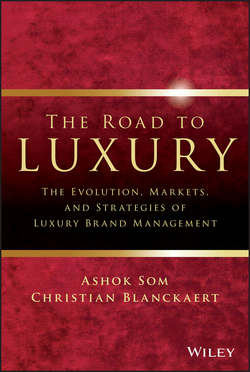Читать книгу The Road To Luxury - Blanckaert Christian - Страница 10
На сайте Литреса книга снята с продажи.
Chapter 1
Introduction
Definition and Crisis of Luxury
The Luxury Industry
ОглавлениеPast crises have had different impacts on varied groups (be it luxury conglomerates or independent luxury houses) at different times; this could be attributed to the exogenous and endogenous characters of the economic cycles. Nonetheless, the 2009 financial crisis was global in nature; it ultimately evolved into the Eurozone crisis and in 2014 is still continuing to affect the major countries in both Europe and America.
To understand the effect of crisis in the luxury industry, luxury must first be divided into (1) hard luxury, such as watches and jewelry; and (2) soft luxury, such as fashion. A more comprehensive definition of the luxury industry includes products and services such as wine and spirits, food, travel, hotels and spas, technology, and cars. Among the most well-known luxury brands are Louis Vuitton, Hermès, Gucci, Cartier, Porsche, Ralph Lauren, Rolex, Tiffany, Armani, Burberry, and Ferrari. In 2012 the worldwide market for luxury grew more than 4 percent over 2011 to a massive €212 billion. In 2013 the worldwide market for luxury grew over 2 percent over 2012 to a massive €217 billion.1
During 2009–2013, this industry felt the impact of the crises. Luxury consumers changed, and so did the industry, with the rise of luxury multibrand conglomerates such as LVMH of Bernard Arnault, Kering of Francois Pinault, and Richemont of Johann Rupert, which were formed by the acquisitions of traditional family-run brands. Other luxury brands (usually family-owned) that resisted being taken over by the aforementioned conglomerates also grew alongside the conglomerates. The family brands protected their brand heritage and DNA; in addition, they purchased their suppliers and integrated vertically. They focused on brand equity, investing heavily in international expansion while repurchasing franchises and licenses to gain more control over their retail operations. Figure 1.2 depicts conglomerates that have a portfolio of brands selling different product categories (LVMH), conglomerates with many brands on one product category (Estée Lauder), companies with one brand and only one product category (Rolex), and houses with one brand with many product categories (Chanel).
Figure 1.2 Where Conglomerates Fall in Different Brand and Product Categories
Due to the oligopolistic nature of the luxury industry, there arose intense competition among the handful of competitors. The most important driver for luxury brands to succeed was, thus, dependent on the disposal income of its clientele, which translated to consumer buying power. The disposable income of high-net-worth individuals had increased during the preceding 10 years. As society become relatively more affluent, consumers with disposal income were “created” through advertising to create an artificial demand for products beyond the individual's basic needs.
1
Compared to the size of the luxury industry in 2014, no formal industry existed even during the 1980s. The luxury industry was an island where a happy few dwelled, unaffected by the worries of life.
